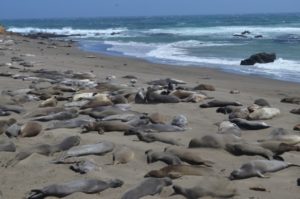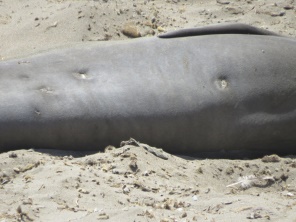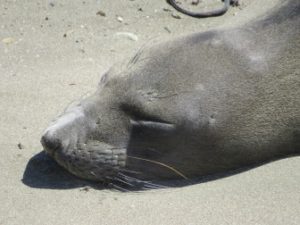For the animal shall not be measured by man . . . They are not brethren, they are not underlings: they are other nations, caught with ourselves in the net of life and time, fellow prisoners of the splendour and travail of the earth.
Henry Beston
A Year of Life on the Great Beach of Cape Cod
As a zoologist, I have had a life-long fascination with the animal world. During childhood, this captivation manifested itself as an insatiable desire to roam the fields and forests of rural Sullivan County in search of subjects for study. Later as an adult, my search became more academic, more specific, more detailed as I studied disciplines such as entomology, ichthyology, herpetology, ornithology, and mammalogy. And still, after decades of attention to the animal kingdom, I often find myself looking at some new, previously unfamiliar species with stunned fascination. Such was the case when I recently encountered the marine mammal known as the northern elephant seal.
In the book of Psalms, David reflects that he has been “fearfully and wonderfully made.” In this case fearfully does not mean in terror or dread. Rather it implies great respect and reverence. Likewise, wonderful does not suggest simple delight but uniqueness or rareness. So too, this verse may represent the exceptionality and matchlessness of this strange denizen of the sea and seashore.
 The beach at Piedras Blancas in coastal California was populated, on the day of my visit, by hundreds of elephant seals. The big bulls were far out to sea so it was females, juvenile males, and young of the year who populated the dark sands. May was molting time for this group and the coats of many resembled a tattered old jacket that should have been discarded long ago. Occasionally a couple of young bulls would begin to feel their oats and a brief barking, shoving, sparring match would ensue. These were but a preview of the fierce, blood-drawing contests in which the big bulls would engage when they returned in late fall. Only the biggest, strongest males could hope to achieve the rank of beach master and be rewarded with the assembling of a harem of 20 to 50 females.
The beach at Piedras Blancas in coastal California was populated, on the day of my visit, by hundreds of elephant seals. The big bulls were far out to sea so it was females, juvenile males, and young of the year who populated the dark sands. May was molting time for this group and the coats of many resembled a tattered old jacket that should have been discarded long ago. Occasionally a couple of young bulls would begin to feel their oats and a brief barking, shoving, sparring match would ensue. These were but a preview of the fierce, blood-drawing contests in which the big bulls would engage when they returned in late fall. Only the biggest, strongest males could hope to achieve the rank of beach master and be rewarded with the assembling of a harem of 20 to 50 females.
Using their forelimbs, there was much flipping of sand upon the backs among the beached seals. This action gave the appearance of small sand geysers erupting sporadically within the colony. Compared to the ocean depths to which these animals may dive, the beach was a hothouse. The coating of sand upon their bodies prevented overheating. I found it interesting that though the main activity was simply snoozing, the elephant seals drew a significant crowd of human observers. The parking area near the beach was large and full. Dozens of people patrolled the walkway overlooking the beach. Many, including myself, stood in rapt wonderment at the spectacle before them. And yet, the show was mostly hundreds of big, sleeping mammals. Why were people so entranced by these representatives of one of Beston’s so-called other nations?
Perhaps, I thought, one reason might be that the elephant seals were so monumentally different from us. Certainly their size was worth a second look. The average American, human male weighs about 198 pounds. Male northern elephant seals can weigh 5,000 pounds. The more petite female seals check in at a svelte 1,000 pounds or so. Even the pups are large and weigh around 60 pounds at birth. By the time they are weaned they have gained nearly 300 pounds.
Because of their lifestyle, the outward appearance of elephant seals must be vastly different than their human observers. However, beneath the skin the seals bear strong resemblance to us. After all, we share nearly 80 percent of our DNA sequences. Their skeletal structure is much like ours. They give birth to live young, nourish them with mother’s milk, and have hair. There is a mammal-ness underlying their strangely different external form. Could this be a source of our apparent fascination? Do the folks who stand mesmerized, staring at the seals do so because they realize these animals are somewhat like us after all?
But we can’t deny their differences either; maybe this is why we are fascinated. Hands have been replaced by paddles, feet by flippers. The body itself is fusiform (streamlined) for speeding through the ocean waters in which they spend the majority of their lives. On the beach, they have an ungainly, lunging, worm-like locomotion; but once in the water, they are transformed into massive, agile torpedoes. Elephant seals can hold their breath for over twenty minutes; the average human for 90 seconds. When pups are weaned after three months, they can already dive deeper and stay down longer than adult harbor seals or sea lions.
Yes, there are many reasons to stand mesmerized as one looks down upon an elephant seal rookery. But, in the end, I believe the attention they foster among us two-legged, terrestrial mammals lies in what we cannot see. It is their behavior when at sea that boggles the mind.
For example adult males leave the rookery beach, usually in March, and begin a monumental swim from coastal, central California. Heading northward and somewhat hugging the coastline, they eventually arrive in waters off of Alaska over 2,000 miles away. The elephant seals from Piedras Blancas will thus migrate some 5,000 miles during the year. Females head more westerly and northerly and range out as far as 3,000 miles. Both sexes are solitary when at sea. There is no partner to help find the way back.
The Pacific, even just the eastern portion, is a big ocean. These are long swims! California has over 800 miles of shoreline. How do they find their way back to their rookery beach? Research has shed light on this question. Apparently they sometimes use landmarks visible when they surface ala “oh, there’s Big Sur just off the port side”. But during dives they spiral downward in a way that could easily disorient them. They may also be far out to sea where landmarks are not available. Thus scientists think they may also be using the earth’s geomagnetic field as do many birds. Others research has suggested that they have a mental map of their migration route and follow this course yearly. But how does an animal form a “mental map” in a vast, liquid environment without landmarks? We may never totally understand how they are accomplishing their amazing navigational feats.
Northern elephant seals fast while on their home beach and may lose forty percent of their body weight. When they go to sea they travel and forage for food twenty-four hours per day. They occasionally drift and sleep briefly on their way up from a dive. The prey of elephant seals includes fish, squid, skates, rays, hagfishes, and octopuses which are taken with a grab and swallow technique.
In order to reach such prey, the elephant seals make dives of 500 to 3,000 feet depth. Males often feed from the ocean bottom while females prey upon their food in the open ocean. The record dive depth for a northern elephant seal is 5,788 feet. This is thought to be deeper than the maximum depth achieved by nuclear submarines with their reinforced, steel hulls. How does an animal made of soft tissues withstand the pressure at these depths? This is an astounding capability for a living creature. The deepest free dive for a human, by the way, is less than a thousand feet.
And there is also this to consider. The water into which they dive is really, really cold. At 3,000 feet it is about 40F. Humans finding themselves submerged in water this temperature face exhaustion or unconsciousness within a half hour. The seal’s secret? Elephant seals are protected by a blanket of fat (blubber) the thickness of a loaf of bread. In times past, this was also a liability because it led to their being hunted nearly to extinction by human, in the same manner as whales. Though today protected from hunting, their blubbery insulation is still the target of a very interesting predator – the cookie cutter shark. These small sharks locate the seals, bite into their skin/blubber, and with a spinning motion pull out a nice plug of fat for their meal. Observing the elephant seals on the beach at Piedras Blancas, it was common to see their skin marred by the scars of a cookie cutter shark bite. More serious threats to the elephant seals are killer whales and great white sharks. Occasionally one will see a seal bearing a large shark bite mark; the sign of a narrow escape from death.
Blancas, it was common to see their skin marred by the scars of a cookie cutter shark bite. More serious threats to the elephant seals are killer whales and great white sharks. Occasionally one will see a seal bearing a large shark bite mark; the sign of a narrow escape from death.
I also find myself astounded by elephant seal predatory behavior because of the way light penetrates the sea water. Below about 600 feet depth, there is not enough light for phytoplankton to carry out photosynthesis. Below 3,000 feet there is no light; the sea is as dark as a cave. And yet they dive to these depths and beyond. Elephant seals have highly light-sensitive eyes, said to be ten times as receptive as ours. This allows them to see any dim, bioluminescent glow given off by their prey even in the darkest depths. When eyesight isn’t an option, they can use their vibrissae (whiskers) to sense the vibrations in the water produced by the movements of their prey.  During dives and surfacing, the vibrissae are held back against the face. At depths, while hunting, they are fanned out to better detect any movement of the water molecules. How is this possible? Could I grow my beard and, with closed eyes, hope to detect the passing of a swallow using only the hair of my face? Even though I have learned these research-derived facts about elephant seals, their behavior still seems miraculous. Finding food in the pitch black ocean depths seems an unintelligible, mystical power to me. The cold, the blackness, the vast volume of water to be searched; how amazing their adaptations and survival skills are.
During dives and surfacing, the vibrissae are held back against the face. At depths, while hunting, they are fanned out to better detect any movement of the water molecules. How is this possible? Could I grow my beard and, with closed eyes, hope to detect the passing of a swallow using only the hair of my face? Even though I have learned these research-derived facts about elephant seals, their behavior still seems miraculous. Finding food in the pitch black ocean depths seems an unintelligible, mystical power to me. The cold, the blackness, the vast volume of water to be searched; how amazing their adaptations and survival skills are.
Female elephant seals baffle me by their apparent sense of time. They range hundreds, perhaps thousands, of miles out to sea. Yet they have some inner “clock” that tells them it is time to return to their rookery beach. They are already pregnant, having mated several months ago. Upon arrival back at the rookery beach, they will all give birth within a few days. What a precise example of time-management this is. How do they know? I am left to wonder.
And then there are the young and their remarkable instincts. They are born, then nursed by their mother for a few weeks. Eventually she simply abandons them. The pups gather in groups (pods) which are usually higher up on the beach where they can avoid the huge, battling bulls. Finally instinct drives them to the sea where they begin to develop their ability to hold their breath, control blood distribution to their internal organs (aka the dive reflex), strengthen their muscles, and find food. And then one day, one by one, they go to sea. They will not return to the beach for several months. It is easy to say, “oh this is all just instinctive behavior.” But I don’t know what that means. What does an instinct look like at the molecular level, the neurological level? It is yet another mystery I must ponder.
Yes, there is plenty to hold one captivated while gazing upon these massive, marine mammals lounging there upon the sands of Piedras Blancas. As I turned to go, more of Henry Beston’s observations of the animal kingdom came to mind. This time I associated them with the elephant seal. Said he: In a world older and more complete than ours, they move finished and complete, gifted with extensions of the senses we have lost or never attained, living by voices we shall never hear.

